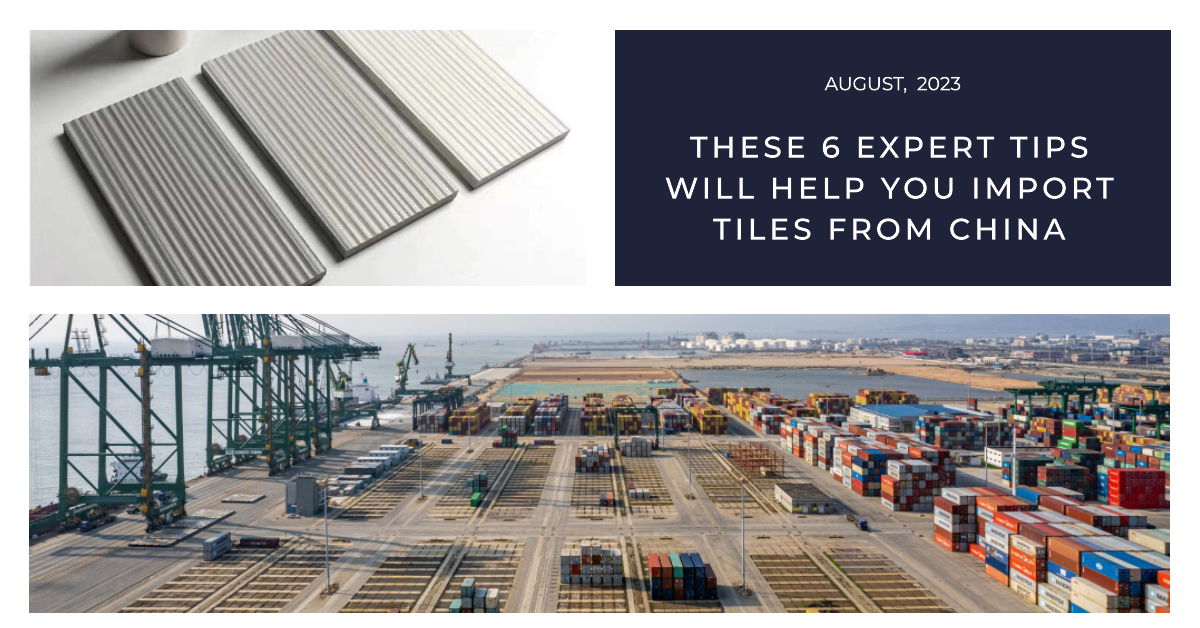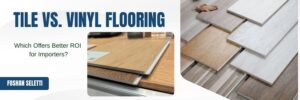China is a significant production hub for the ceramic tile sector in the thriving global commerce market. It has caught the attention of importers from all over the world with its combination of quality, variety, and affordable pricing.
However, negotiating the intricacies of importing tiles from China can be difficult, particularly for individuals new to the tile industry or importing ceramic tiles from China.
The following article seeks to give helpful tips for overseas importers involved in the tile business. We’ll go over crucial issues to consider when importing tiles from China, such as verifying the porcelain or ceramic tile you buy is legal in your nation and understanding the shipping, customs process, import taxes, and duties.
Whether you’re an experienced importer or just starting, these tips can help you navigate the Chinese tile market more confidently and efficiently.
So let’s get started!
Tips 1: Ensure the ceramic or porcelain tiles you want to import are permitted in your country
Some products are not allowed to be imported, and different countries have different restrictions and prohibitions. Therefore, before you import porcelain tiles from China, please ensure that they are permissible. At the same time, you need to know whether importing tiles to your country requires an import license, what certifications or inspections need to be met, whether you have any labeling requirements for the packaging, what documentation is needed for customs clearance, and so on.
Failure to follow import rules and regulations can result in significant penalties such as fines, product confiscation, and blacklisting of the importer.
All of these obstacles we have to overcome before starting the tile business.
Therefore, ensuring that tile imports comply with all legal standards and regulations to minimize risk and possible penalties is the first step to ensure that tiles smoothly enter your market.
Tip 2: Verify whether your nation has anti-dumping duties on Chinese tiles
Another crucial aspect to consider when importing tiles from China is the potential existence of anti-dumping duties. The anti-dumping tax protects the domestic tile manufacturing industry and prevents ‘dumping’, the lower import price would harm the domestic industry market.
Anti-dumping duties can significantly impact the total cost of importing tiles. In some instances, these duties can make importing certain products economically unviable. Therefore, it’s essential to check whether your home country has anti-dumping regulations against tiles imported from China.

For example, in November 2019, the United States imposed a definitive anti-dumping duty on imported tiles from China. The rate range from 229.04%-356.02%. With such a high anti-sale tax rate, it can be said that the possibility of importers importing from China is nearly zero.
Therefore, before importing, it is advisable to stay updated with the most recent trade policies and news, as these regulations can change over time.
For more accurate and current information, you can also find this information on the website of your country’s trade or customs department. If you are unsure, speaking with a trade lawyer or a customs broker may give you a more thorough knowledge of these duties and how they may influence your tile import business.
Tip 3: Calculate the landing cost and be aware of any import-related expenses
Understanding the overall cost of importing Chinese tiles is critical for company planning and profitability.
This overall cost, we often referred to as the ‘landing cost’, includes three main components:
Product Price: This is the cost of the ceramic and porcelain tiles themselves, as quoted by the manufacturer or supplier in China.
Transportation and Shipping Freight: These are the costs of transporting the tiles from the supplier’s location to your destination port. It includes charges for shipping (by sea, air, or land) and any additional fees related to loading/unloading and insurance.
Customs Clearance, Import Duty & Tax, and Inland Transportation Fee: These are all costs related to getting the tiles into your country and warehouse. They include fees paid to customs brokers for handling the import process, taxes imposed by your government on imports, and the cost of moving the tiles from the port of entry to your warehouse. Depending on the product type and the place of origin, prices may change.
All these costs add up and significantly impact the total cost of importing tiles from China. It’s essential to calculate all these costs into your landing cost strategy. By doing so, you can ensure that your tile import business remains profitable and competitive.
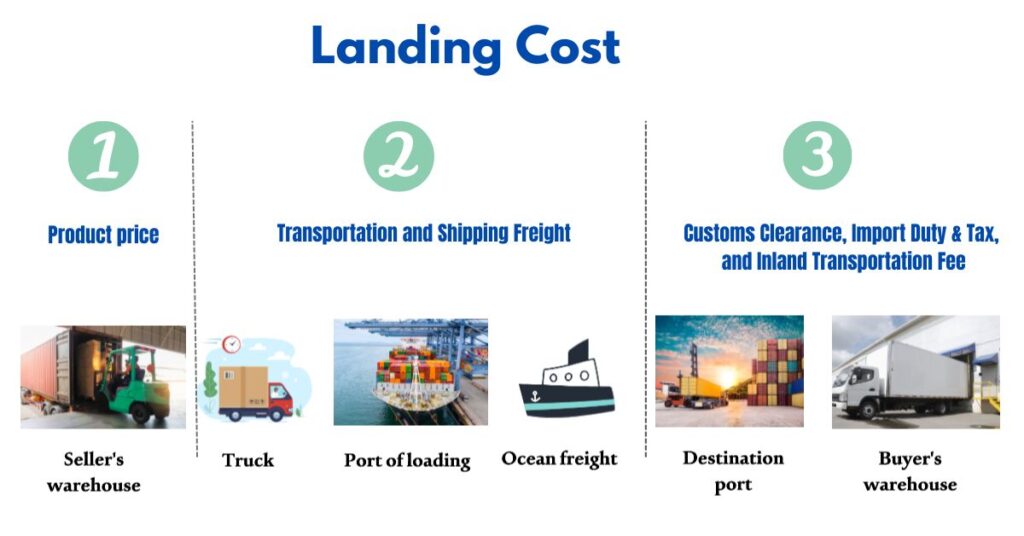
Tips 4: Clear the trade terms, shipping modes and loading port
Navigating the world of international trade involves understanding various terms and conditions that govern transactions. Here are three key areas you should familiarize yourself with:
Trade Terms (Incoterms):
Trade terms, also known as price terms, are gradually formed in the long-term practice of international trade. By using the trade terms, The composition of the transaction price and delivery conditions are determined. And it also clarified the cost, risk, and responsibility between the buyer and seller throughout the trade process.
Generally speaking, EXW, FOB, CFR, and CIF are the most commonly used trade terms in the porcelain and ceramic tile industry. Here’s a brief explanation of each:
FOB Price (Free On Board):
The vendor is responsible for delivering the products to the port of shipment and loading them into the ship. Once the goods have been loaded, responsibility transfers to the buyer, who is responsible for covering all transportation charges to the item’s destination.
CFR Price (Cost and Freight):
The seller is liable for all costs in transporting the goods to the destination port. However, when the products get aboard the ship at the port of origin, the risk of damage or loss is shifted from the seller to the customer.
CIF Price(Cost, Insurance, and Freight):
Similarly to CFR, the seller must pay shipping costs to the destination port.
The different is, the seller additionally covers the cost of insurance to protect against the possibility of loss or damage while in transit.
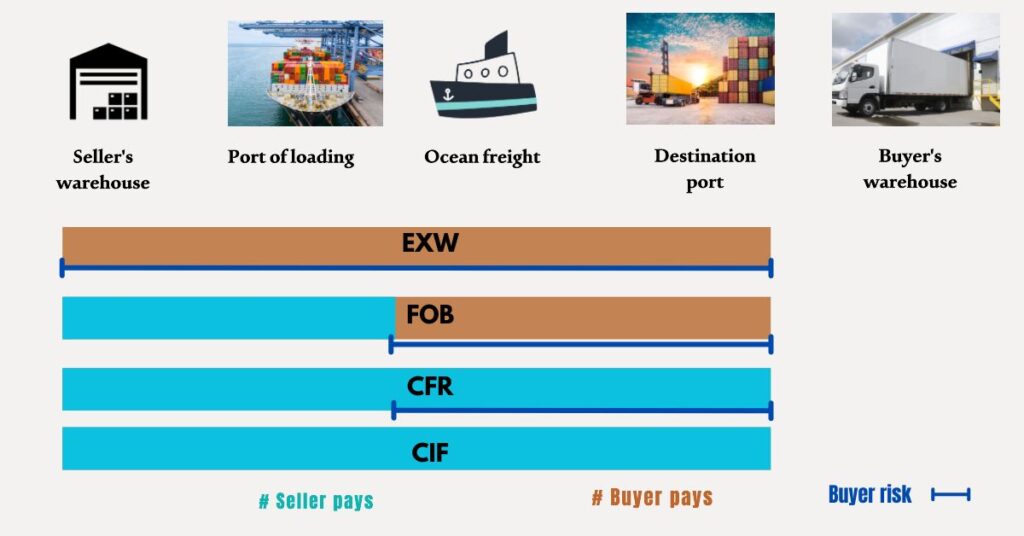
EXW Price( Ex works):
This is another important term in international trade. Under the EXW term, the seller only agrees to make the goods available at their warehouse or designated place. This means as a buyer, you need to arrange the transport from the factory warehouse to your shipping forwarder’s warehouse or the loading port. You are also responsible for paying the costs of packing the items into a truck, transportation, customs clearance, tariffs, and port handling fees.
Knowing these trade terms will help you bargain more effectively with your suppliers, and pick which is the most beneficial method of shipping and handling for you.
Shipping modes: by sea and by rail or road
The shipping mode you choose will depend on factors such as the size of your order, how quickly you need the tiles and your budget. Common shipping modes of the porcelain and ceramic tiles include by sea ( most cost-effective for large quantities) and by rail or road ( Usually used for transportation in a landlocked country with no seaside ports, such as Kazakhstan, Uzbekistan, Kyrgyzstan, Tajikistan, Turkmenistan, and Mongolia ).
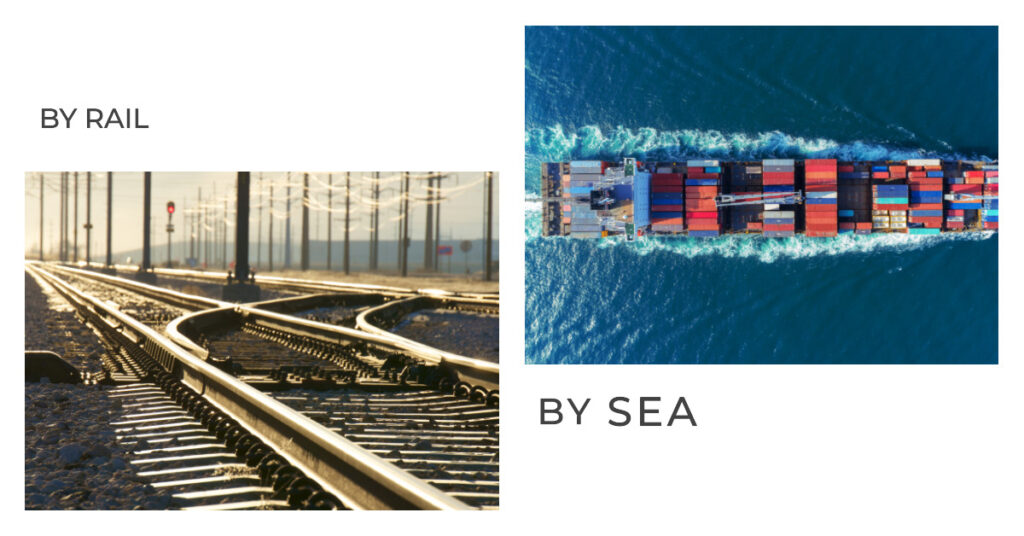
Full Container Load vs. Less than Container Load
Regarding shipping, your decision will largely depend on the volume of your tiles cargo. There are two main types of load:
FCL (Full Container Load):
This term is used when you have enough quantity to fill an entire container by yourself (usually are 20 feet container, called 20gp for short). It’s typically faster and cheaper per unit than LCL because you’re not sharing space with other shipments. FCL can be the most economical choice if you’re importing a lot of tiles.
LCL (Less than Container Load):
LCL is when your shipment doesn’t fill up an entire container, and you have to share the container space with other shippers. This can be a more economical choice if you’re importing smaller quantities, as you only pay for the space you use. However, due to the additional logistics required to combine and separate the numerous shipments, it may take a longer time.
If you want a large variety of products with small quantities of each, you can collect all your goods from several suppliers and load them into a full container for a lower overall cost. And if you are not sure which shipping way is the most saving-money yet, you could find a reliable forwarder or supplier to help you.

Port of loading
The port of loading is the port from where the shipment begins its journey. If you importing tiles from China, it could be one of China’s major ports like Foshan, Guangzhou, Zhaoqing, Shenzhen, Xiamen, Fuzhou, Qingdong etc.
The choice of the loading port can affect shipping costs and transit times, as well as the frequency and timing of routes, so it’s an important factor to consider when planning your import process. As a ceramic and porcelain tile supplier, in order to minimize inland transportation costs in China, we typically choose a loading port that’s closest to the warehouse.
Tips 5: Start with a sample or trial order
Before committing to a large order, it’s wise to request a sample or place a trial order. This allows you to evaluate the tiles’ quality and the supplier’s reliability without assuming too much risk.
Sample Order: Most suppliers will provide samples of their products, often for a small fee or sometimes even for free.
You may get a good understanding of the product’s quality, color, texture, and other attributes by looking at a sample. It’s also a terrific chance to evaluate the supplier’s order handling and communications abilities.
Just imagine if your supply provides samples with chipped edges, chipped corners, and without item numbers in these samples. Are you really comfortable giving him your order for production?
Trial Order: If you’re satisfied with the sample, consider placing a small trial order next.
It enables you to test every step of the ordering process, from payment to manufacturing to shipping and delivery. It might also assist you in determining exactly how well the provider manages larger orders.
By starting small, you can identify any potential issues or challenges early on and make necessary adjustments before placing a larger order. In the long term, such a method can save you time, money, and hassles.
Tips 6:Do not always look for the lowest price
While it’s natural to look for the best deal when sourcing products, choosing a tile supplier based solely on price could cost you more in the long run. Here’s why:
Quality Concerns:
A significantly lower price could indicate lower quality materials or craftsmanship. Poor quality tiles could lead to customer complaints or even affect your brand reputation.
Reliability Issues:
If a supplier offers prices much below market rate, they might be cutting corners elsewhere – such as customer service, timely delivery, or consistent supply.
Long-Term Relationship:
Working with a slightly more expensive supplier who is reliable, communicates well, and consistently delivers high-quality products can be more beneficial in the long run. It can lead to better business relationships, fewer headaches, and potentially loyal customers.
We once encountered a tile vendor, who was eager to win a new customer’s order, she offered a much lower price than the going market rates.
And the customer from overseas placed an order and promptly paid the required deposit.
However, as the weeks turned into months, the ceramic tiles never arrived. The vendor was constantly delaying the shipment for various reasons. And the buyer was very frustrated and angry. In the end, he made a beeline for the supplier’s booth at the Canton fair, and a heated argument broke out over the return of the deposit.
Although this type of circumstance is uncommon, it serves as a harsh warning: Be aware of the low-price trap.
Remember to take into account aspects like product quality, delivery time, and supplier dependability in addition to pricing while selecting vendors. A more worthwhile business and better decisions can come from this balanced strategy.
Conclusion:
In this global trading marketplace, tile sourcing overseas can be a hassle and very complex. Still, it can also be a rewarding venture with careful planning, understanding of the import process, knowledge, and clear all the cost components, shipping terms, and modes.
Remember to focus on product price and consider other factors such as quality, delivery time, reliability, and communication when choosing your suppliers. Starting with a sample or trial order can help mitigate risks, and always beware of deals that seem too good to be true.
Even though there could be obstacles in the path, like in our story of the buyer at the Canton Fair, such experiences teach vital lessons about the process of international trade.
Keep these six suggestions in mind as you begin your tile-sourcing adventure in China, and you’ll be well on your way to developing fruitful, long-term partnerships with suppliers and, most importantly, expanding your business and margin.
We truly hope that this information is useful to you.
Until next time, happy sourcing!

